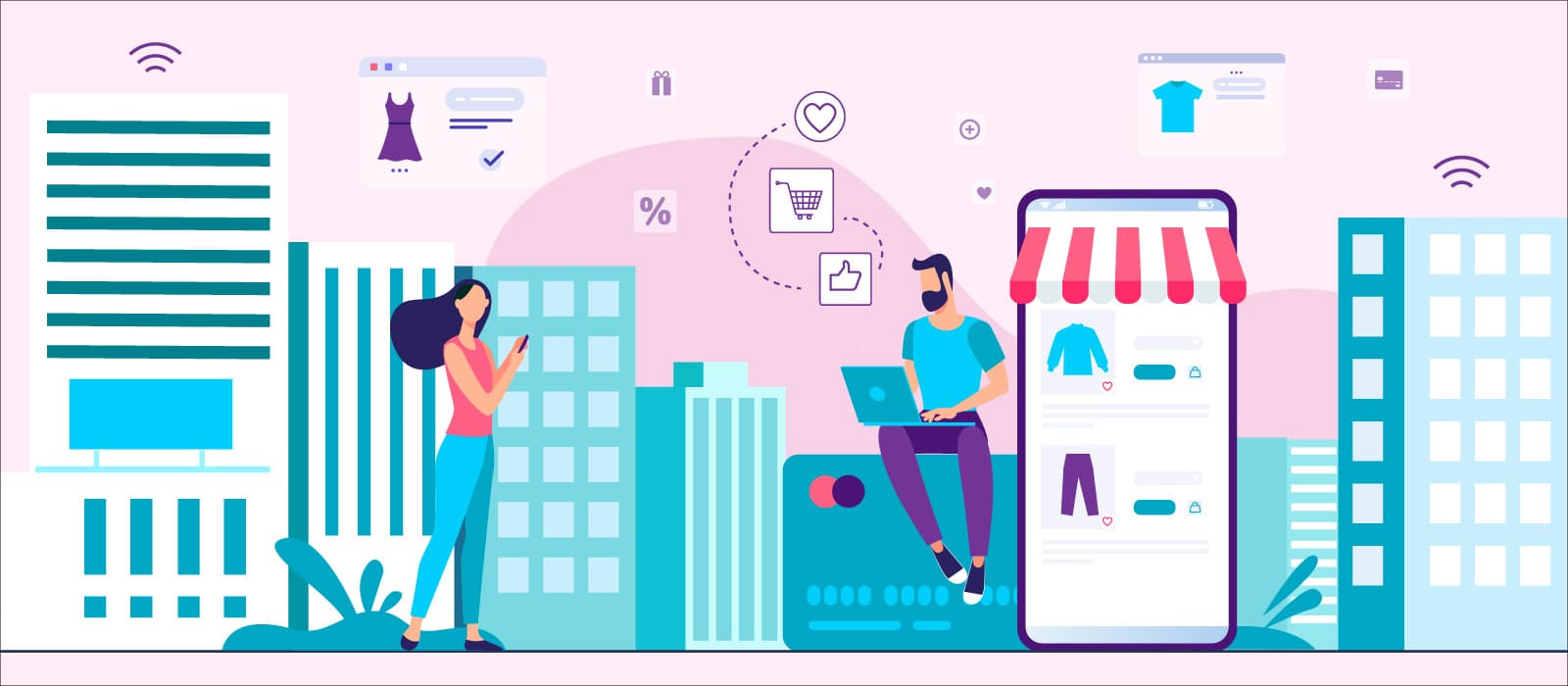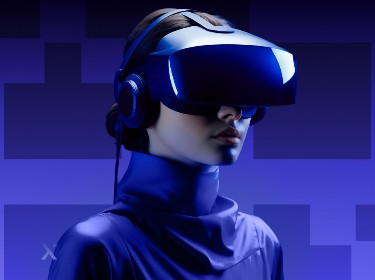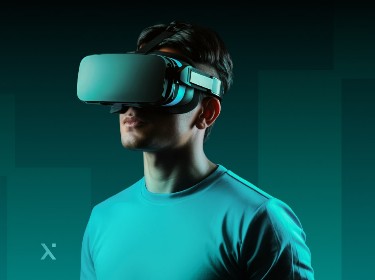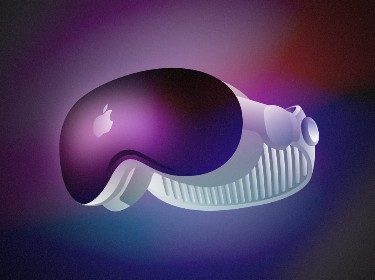Augmented and Virtual Reality technologies seem to provide a brand new experience when shopping.The advanced technology will make it possible to address popular customer concerns and make stores more appealing and sophisticated. This is the reason why forward-looking online and offline retailers have already started applying AR and VR tools.
Today it’s more important than ever to build engagement with customers and make sure that your relationships will be friendly, long-standing and harmonious. But how can AR and VR development service contribute to enhancing shopping and attracting more satisfied customers?
Let’s find out together!
AR and VR in shopping and retail: the future of shopping is virtual and augmented
Crowded shopping areas, poor navigation, ill-thought-out product display, pushy, arrogant and indifferent shop assistants — this is an incomplete list of the most frequent customer complaints about brick-and-mortar shopping.
Still, the advent of eCommerce has managed to resolve some of these issues. Nowadays people can buy everything they want — from food to furniture — from any part of the world. However, this kind of revolution has led to a number of new challenges. Sometimes the products we buy online do not live up to our expectations. Catalog photos, for instance, don’t possess 3D features making it impossible to study the product in greater detail. That leads to a great number of returns, which is neither pleasant for customers, nor beneficial for shops.
Fortunately, AR and VR solutions are here to address these and many other issues in the retail industry. These new techs are perfectly capable of converting a first-time customer into a loyal fan. Moreover, Augmented and Virtual Reality tools can turn an ordinary shopping spree into a multi-sensory brand experience that a customer will look forward to.
What is Augmented Reality?
If you think that you’ve never faced Augmented Reality or never used AR tools, remember Pokemon GO, a wildly popular AR game released in 2016. It seems like a lifetime ago, right? So, this one is a good example of AR usage, and you might have noticed how truly immersive that was!
In technical terms, Augmented Reality is an immersive tech that adds a digital layer to the immediate physical environment. By using AR software, you can view computer-generated images and interact with them.
There are three types of AR applications:
- Projection-based
The image of an object is projected onto some physical surface. For example, when playing with an AR tennis ball made of light and color, it can be sent back and forth like a real object.
- Location-based
Apps like these help find interesting places in the vicinity by adding useful facts, tips, and hints to the image that you are focusing on.
- Recognition-based
A basic example of a recognition-based solution is a QR code that you scan to get additional info about a product or place. In this case, an app recognizes an object and replaces it with the relevant AR content.
Thanks to Augmented Reality, it’s possible to erase borders between the real world and the digital one. By utilizing graphics, sounds and even smells that it offers, we acquire a better understanding and vision of various objects and things.
Augmented Reality statistics
Even though immersive reality may sound like sci-fi to some people, there is solid data to prove its practical value for the present and future of retail. Still in doubt? Have a look at the statistics below that demonstrate the potential of AR:
- By 2023, the number of AR app users worldwide will reach 1.7 billion.
- The tech will pave the way to a number of industries including healthcare, travel and tourism, construction, shopping, and more.
- By 2023, the estimated number of VR headset shipments will increase to 30M.
- 71% of customers are sure they would shop more often if they could use AR tools.
- 61% of consumers say they would prefer a retailer applying Augmented Reality solutions.
- 40% of people are ready to overpay for the convenience and fun that AR tools provide.
- The AR market is rapidly growing and its value may reach 26 billion U.S. dollars by 2025.
As you see, the implementation of AR technologies is growing exponentially. The facts and numbers above can make retailers think about integrating immersive reality solutions into their businesses.
Augmented Reality vs Virtual Reality
AR technology is often confused with Virtual Reality (VR). Non-specialists may use these terms interchangeably, but it’s crucial to know the difference. Simply put, AR extends and complements the existing reality, whereas VR creates a totally new digital environment out of thin air.
To experience virtual reality you won’t be able to do without a special device. If you want to attend a VR show or play a VR game, for instance, you need a headset that will transport you from the surrounding environment to a new reality that moves in sync with your head.
However, in order to see augmented reality elements, you don’t need any goggles or a headset. All you have to do — is just to install a special app on your mobile device and aim the cam at an object. Besides, there are also web-based solutions allowing you to augment the existing reality by opening an AR-link in a standard browser.
For businesses looking to create such immersive experiences, partnering with a reliable custom mobile application development company is essential. These specialists design tailored solutions that perfectly align with any project requirements and user expectations, ensuring seamless integration of VR and AR technologies across mobile platforms.
How AR and VR tools improve shopping experience and retail
![]()
Millennials and Gen Z customers are not pleased with traditional shopping and prefer to buy things using a mobile device. Besides, they can get easily bored with the shopping process and be sensitive to prices. To attract this demanding audience, retailers have to make the process more visually appealing, personalized, interactive, and loaded with exciting experiences. Luckily, AR and VR tools have already come up with ingenious solutions for attracting and retaining these two generations and not only.
- Creating virtual encounters
A traditional online store interface with its plain catalog-like display cannot compete with a dynamic and photorealistic AR/VR showroom. A customer can roam around 3D space for hours, interacting with products. Thus, retailers can combine the elements of both online and offline formats and create a mesmerizing experience, making shopping more engaging and accessible than ever before.
- Virtual trying and testing
A lot of online shoppers tend to… suffer (really) from buying unsuitable products. It happens so because they don’t have an opportunity to touch or try them on before buying. The absence of pre-purchasing contact is also the reason why a lot of people abandon their carts: they cannot overcome indecision. With AR solutions, you can easily give a digital couch a 360-degree turn, or try on digital clothes, or test digital beauty products on your face. The possibility to learn more information about a product before buying it could bring more satisfied customers and lead to their better shopping experience.
Check out how this VR real estate platform generates 360-degree virtual tours
- Contextual try-ons
This wow-feature allows you to place yourself in any environment that you like. For instance, if you and your partner are buying ski suits, it would be nice to see how the two of you look on the slope; or if you are buying a couch, you may want to transfer it to your room to make sure it agrees with your home decor. The range of such contexts is endless, and the process itself proves to be entertaining and engrossing.
- Designing custom goods
When you order clothes, accessories, or other items to be designed specially for you, you’re likely to get something slightly different from what you expected. Augmented Reality tools help solve this problem and make sure that it won’t happen. Designers can provide their clients with an exact digital copy of the item before getting down to the creation. It saves a lot of time, expensive materials and disputes, making both clients and designers happy and ready for further creative cooperation.
- Personalization
In traditional shopping, a customer relies on a shop assistant for personalized support. Unfortunately, introverted people feel uncomfortable talking to strangers. Moreover, shop assistants may be pushy, annoying, or over-enthusiastic. Oh yes, one more aspect to consider: recent social distancing rules don’t encourage person-to-person interaction.
Luckily, Augmented Reality apps come to the rescue. Now you can visit a smart AR shop that remembers your personal preferences and metrics and is ready to guide you around the area.
Besides, the technology even shows concern about your health. For example, if you are allergic to some fiber, there some apps that might warn you against purchasing a product that contains it and suggest some other safe alternatives instead.
- Better brand exposure
These days, a brand that uses AR tools motivates many people to try new features and share their experience on social media. This grapevine approach brings tech-friendly companies into the spotlight and provokes faster organic growth. Fancy VR events can also bring more potential customers closer to the brand, especially when shows are impossible to conduct due to lockdowns.
- Reduction of returns
Statistics show that people return about 30% of all goods they buy online. For offline stores, the number of returns equals to 9%. Therefore, most frequent customers tend to buy from a retailer with better return policies and free shipping. It goes without saying that such practices mean extra costs that retailers would prefer to avoid. In this way, AR/VR shopping tools allow customers to examine a product in greater detail and make an informed decision. Thus, it reduces the number of returns and decreases those related costs.
- In-store navigation
What do you usually do once you’re in a store? In all probability, you (just like all of us) desperately look around trying to find the goods that you need or like. This activity can be tiresome and even a bit stressful to some people. However, even here AR has carved a niche for itself. Retailers have introduced in-store navigation that contributes to a seamless, faster and stress-free shopping experience. There’re also specially designed apps that allow you to create shopping lists using a store’s catalogue and then find the fastest path to get to these products.
- Better product presentation = enhancement of marketing strategies
Augmented Reality is capable of bringing about considerable improvements in various sales and marketing processes. In the B2B sector AR can enhance sales presentation material. Gone are the days when brochures and flyers were the only means of conveying information. Instead, retailers will provide a virtual 360-degree look at their product lines. The mobile experience can also contribute to improving marketing. Handy and fun AR features in brand apps will help retailers promote communication with buyers.
- Connect both online and offline
As a retailer, you want your customers to come back again and not lose connection with them, be it either online or offline. For this purpose, you’d better provide interactive content that customers can explore whenever and wherever it’s convenient for them. This will lead to building brand loyalty.
But how can AR assist you here? AR packaging has a space for giving additional information (recipes, rewards, special codes and so on). This extra contact can rotate around entertainment as well — use kids’ cereal boxes and add AR fun activities and/or storytelling to the packaging. Bear in mind, though, that the content that you place should educate, entertain and inspire.
AR use cases in retail
Augmented reality instruments like AR shopping apps can take customer-retailer relationships to a whole new level. AR tools encourage people to make a purchase and increase the probability that buyers will come back for more shopping experiences.
The most striking thing is that AR knows no boundaries and can come in handy in many retail’s directions. Here is the list of the most prominent use cases shortlisted by our augmented reality app development company:
Home Improvement
![]()
If you’re having your apartment redecorated, you’d better be in the know about an AR/VR app for home design. It helps you choose not only the color for walls but also matching furniture.
Myty — an augmented reality shopping application — is packed with a lot of filters. With the help of this app, you can find the furniture to your liking and move it around the room, finding the most suitable place for it.
Another example is the DecorMatters app that combines AI and AR solutions. Thanks to it, you’ll be able to redefine your interior design and buy the items that will be a perfect match for your interior.
Owners of iOS devices can try IKEA Place – an AR app which enables users to check whether IKEA items of furniture will fit the room or whether the colour of this or that item matches the entire colour palette of the interior.
Beauty
AR solutions can be applied in the beauty industry as well.
Those who are fond of cosmetics, will be glad to learn that they will have a chance to test lipsticks and eye-shadows without applying, washing off, and re-applying the real stuff. Using virtual try-on features, they can have a look at whether this or that color matches their skin tone.
Furthermore, by testing realistic simulations, it’ll be possible to reduce product waste and make try-ons 100% hygienic and safe. The pioneers who launched AR beauty apps are ModiFace, Sephora, and YouCam Makeup. However, there are many more popular brands on the market who have ventured into AR and seem to be pleased with the result.
Fashion
AR/VR reality is the hottest trend in the fashion industry. It opens doors to many new opportunities both in offline and online shopping malls.
Apart from AR mobile shopping apps and VR catwalk shows, there are augmented mirrors and window displays that allow users to browse through new collections without even entering the shop.
From a practical viewpoint, Augmented Reality applications reduce the number of returns, improve in-store navigation and help customers find suitable garments. Among the examples of how AR/VR solutions have been implemented in the fashion industry are Converse (AR-powered shopping app), Chanel (VR makeover and AR promo events), Prada (VR experience), and Zara (augmented window displays).
Jewelry and watches
Some people believe that diamonds are a symbol of timeless elegance. However, the jewelry market has to keep up with the times to engage with potential customers. That’s why AR jewelry apps have been designed in such a way to attract more clients and guarantee exciting experience.
These apps give customers a 3D view of a jewelry item and allow them to have virtual try-ons. All you have to do is just to scan your hand or face with a camera and put on a selected item. This feature allows buyers to try on as many items as they want and removes the necessity to go to a brick-and-mortar boutique.
The Tryon Jewelry app promises its users “a mind-blowing try-on experience”. And if you’ve ever dreamt of Gucci watches, you’ll be amazed to learn that now you can try them on your wrist with the help of their recently launched iOS app.
Food and wellness
If you prefer organic, or locally-grown, or ethically produced foods but always experience difficulties in spotting them in the store, you can rely on special AR apps. Thanks to them, you will easily find your way around a supermarket and find the items on your grocery list. You can even learn more about their calorific and nutritional value. How? — Once you point the camera at a product, an AR mobile app provides all the information about it. Thank God! We won’t have to squint any more to read the list of ingredients on the label…
Walmart is one of the first supermarkets to try the implementation of an AR app. Even though Me@Walmart is an in-house application, providing a range of useful functions to the employees, it still makes the lives of customers much easier. For example, the app locates the shelves which lack products and informs employees in charge to refurbish them as quickly as possible.
Vehicles
It might seem inconceivable but AR tools have managed to smash their way even in the automotive retail industry. There already exist apps that provide relevant technical data about vehicle specs when you just point your phone camera at a certain part of the car.
Augmented Reality instruments also demonstrate features that would be hard to discern in a traditional showroom. Moreover, auto enthusiasts can reconfigure their cars by using a special AR app that enables them to have a 3D preview and see all the details.
The notions described above have sparked RELAYCARS’s interest to introduce immersive virtual car showrooms. Audi has also decided not to lag behind: they have grown fond of the idea of utilizing a VR headset for car configuring.
AR and VR marketplaces
![]()
It comes as no surprise that the world’s biggest and popular online marketplaces are already experimenting with AR and VR tools. They’ve successfully incorporated them in their processes and managed not only to retain regular customers but also attracted new ones.
Alibaba
The Chinese retail giant Alibaba has recently added AR features that enabled it to make shopping more entertaining. Customers got an opportunity to take virtual try-ons and enjoy a drive in a digital car. The idea has appealed to many people and boosted Alibaba’s sales.
Amazon
Amazon offers its customers a cutting-edge AR tool called Room Decorator. With this app, you can integrate any piece of furniture or any other decor element into your room. The best thing about the app is that it can manage many items at a time, making it possible to see how they look together.
Walmart
The American retail corporation has made price checking easier than ever before. The recent update of the Walmart shopping app comes with a special AR scanner. Its functioning principle is quite simple: you scan a product with your camera and see its price and reviews. Sounds curious and really handy, right?
Gap
The new AR shopping app by Gap provides you with a 3D mannequin that demonstrates the selected garment. You can ‘play’ with the size of the dummy and see how a particular garment would look on different body types. The app also possesses a smart and convenient feature — it remembers your height, weight, and other important measurements.
The future of AR and VR technologies in shopping and retail
Augmented and Virtual Reality technologies have gained prominence in a number of industries and they keep on enhancing by leaps and bounds.
As for the retail industry, it’s almost certain that more and more businesses will be gradually switching to AR and VR tools in order to enhance customers’ shopping experience. The range of opportunities is enormous and diverse: from virtual try-on apps to photorealistic AR/VR showrooms. The convenience, positive feedback from customers and financial gains are guaranteed.
More than that, buyers encourage and approve of the further AR and VR development. These technologies allow everyone to learn more details about products, provide a comfortable and stress-free shopping environment, and help make informed decisions when buying a product. For sure, the most awesome feature of all is the unique customer experience. There is simply no way that Augmented and Virtual Reality tools not strike a chord with lots of people.
If you’re searching for reliable augmented and virtual reality development services or a professional retail software development company — contact us any time.
Our experienced consultants and developers will answer all the questions you might have and will provide the best solution.




